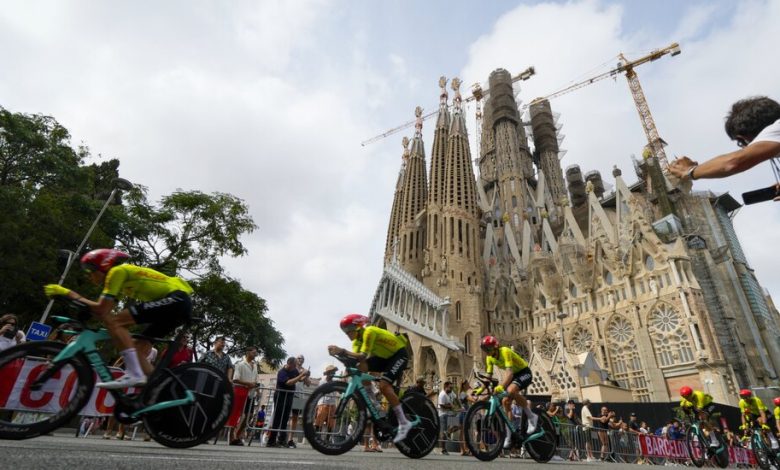Barcelona’s Unfinished Masterpiece Is Now a Little More Finished

More than 140 years after a Spanish bishop laid the cornerstone of Barcelona’s Sagrada Familia basilica, the famously incomplete church is inching toward the finish line, with five of its six central towers now finally fully built as of last week.
But with construction expected to continue, would-be pilgrims to the site — one of Barcelona’s most iconic monuments — should not expect to see Antoni Gaudí’s structurally audacious masterpiece fully realized until 2026 at the very earliest.
The Junta Constructora del Temple Expiatori de la Sagrada Família, a foundation that oversees the church’s construction, said work had been completed on two of the church’s main towers. Together with two others finished last year, the four symbolize the Evangelists: Matthew, Mark, Luke and John, the authors of the canonical Gospels recounting Jesus’s life.
“The four towers of the Evangelists are finished!” the church foundation wrote on the X platform, formerly known as Twitter, last Friday. In a statement last Wednesday, the body announced that a special Mass would be held to celebrate the occasion on Nov. 12.
The Sagrada Familia’s radical design, which incorporates elements of Gothic revival, Art Nouveau and modernism, draws millions of tourists a year and is part of a UNESCO world heritage site comprising seven buildings by Gaudí in Barcelona. It evoked opposite emotions in George Orwell, the British writer, who called the church “one of the most hideous buildings in the world.”
The four completed towers were crowned with sculptures of winged figures associated with the Evangelists: an ox, an eagle, a human and a lion, the church foundation said. The structures stand at about 442 feet, or 135 meters, which will make them the third-tallest towers of the church when it is finished.
Mr. Gaudí, the brilliant and idiosyncratic Catalan architect, spent much of the latter half of his life designing and building the church. The cornerstone was laid in 1882, and Mr. Gaudí worked intensively on the project until he died after being struck by a tram at the age of 73, leaving his great work unfinished.
Generations of Spaniards have lived and died with the massive church still under construction, its lofty, partly completed spires occasionally swaddled in scaffolding or surrounded by cranes. In November 2010, Pope Benedict XVI consecrated the church as a basilica and held a Mass there before 7,000 people.
The Sagrada Familia foundation has said it still hopes the tallest and central tower, which represents Jesus, will be finished by 2026, the centennial of Mr. Gaudí’s death. It was unclear when or if other proposed elements, such as a grand staircase, would go forward.
After Mr. Gaudí died, construction of the building was plagued by delays and fierce controversy for decades. Critics contended that successive architects were unable to hew to Mr. Gaudí’s original vision — some of his plans were destroyed long ago — or argued that the unfinished character of the building has become part of its enduring lasting appeal.
Several years ago, the Barcelona municipality accused the church of failing to have a proper building permit, an accusation it rejected. In 2018, the Sagrada Familia agreed to pay city authorities some $41 million over 10 years to settle the dispute, as well as fund transportation improvements around the complex.
Some officials with the foundation had previously warned the Covid-19 pandemic could push back the ribbon-cutting past 2026, as construction was temporarily halted and travel restrictions cut off the steady stream of visitors whose tickets help fund the project.
“Gaudí didn’t see it finished, and I won’t either,” Jordi Bonet, a former chief architect on the project, told a documentary filmmaker years before his death last June at the age of 97.
